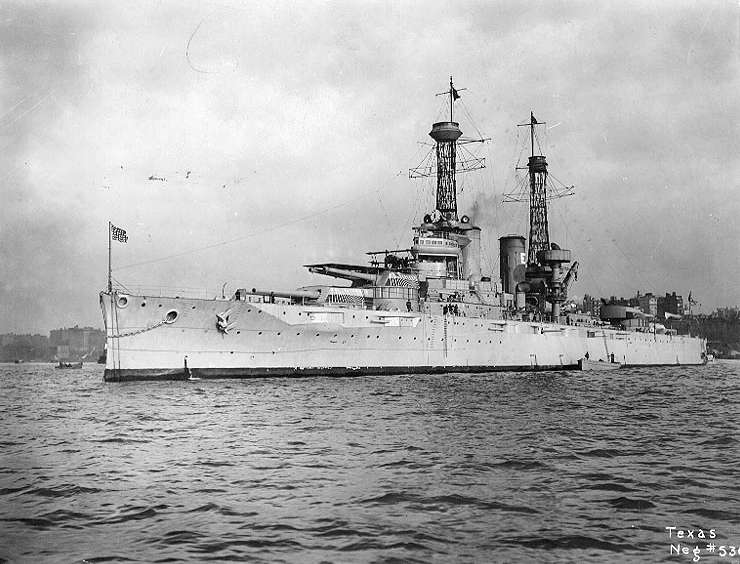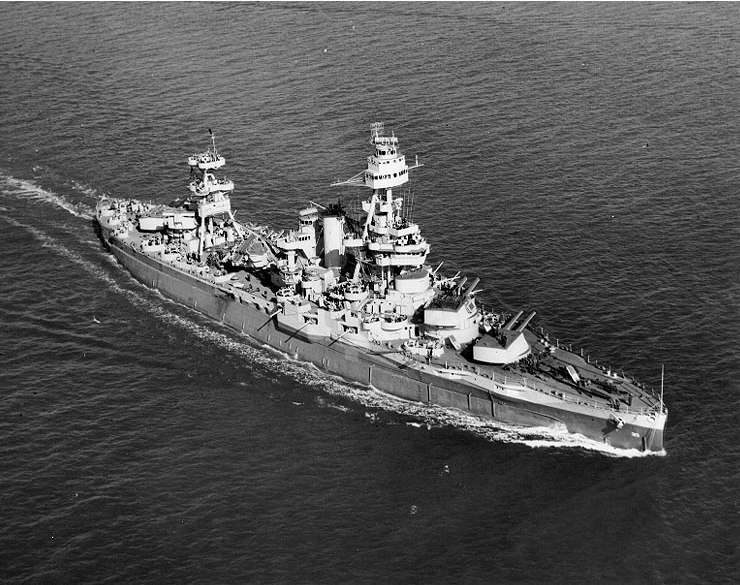The intentional flooding of the USS Texas on D-Day, June 6, 1944, during the Allied invasion of Normandy in World War II, is a remarkable example of ingenuity and determination in combat operations.
The USS Texas (BB-35), a New York-class battleship, played a vital role in supporting the Allied troops as they stormed the beaches of Normandy.
The story goes that to increase the range of her guns, the crew of the USS Texas came up with an innovative solution.
The battleship needed to elevate its guns further than their design allowed to support troops further inland.
To achieve this, the crew intentionally flooded the torpedo blisters on one side of the ship. This action listed the ship to one side, effectively increasing the elevation angle of the guns on the other side.
USS Texas – Design Specifications
The USS Texas (BB-35) stands as a significant piece of naval history, embodying the technological and architectural advancements in battleship design of the early 20th century.
Commissioned in 1914, this New York-class battleship was among the most formidable naval assets of its era, designed to project power and assert dominance on the high seas.
With a standard displacement of about 27,000 tons, which increased to over 34,000 tons after extensive modernizations in the 1920s and 1930s, the USS Texas was built for endurance and resilience.
Its overall length of 573 feet (about 175 meters) and a beam ranging from 95 to 106 feet, depending on modifications, gave it a formidable presence.
The draft of the ship, the vertical distance from the waterline to the bottom of the hull, was approximately 28.5 feet, allowing it to navigate a variety of water depths strategically.
The propulsion system of the USS Texas was a marvel of its time, consisting of steam turbines that powered the battleship to speeds of up to 21 knots (about 24 mph or 39 km/h).
This capability ensured that the Texas could operate effectively across the vast expanses of the Pacific and Atlantic, ready to respond to threats or strategic needs as required.
 The Dreadnought Battleship USS Texas off New York in 1919.
The Dreadnought Battleship USS Texas off New York in 1919.
Armament was a key feature of the USS Texas, equipped with ten 14-inch (356 mm) guns arranged in five twin turrets.
These powerful weapons enabled the battleship to engage enemy targets at significant ranges, asserting its dominance in naval warfare.
Additionally, the ship was outfitted with a complement of 5-inch (127 mm) guns, anti-aircraft guns, and, as technology advanced, modern anti-aircraft weaponry to defend against aerial attacks.
Protection was paramount in the design of the USS Texas, which boasted extensive armor. Belt armor reached up to 12 inches (305 mm) thick, providing critical defense against enemy fire.
The turret armor was even more robust, up to 14 inches thick, safeguarding the gun crews and their vital equipment. Deck armor, up to 3 inches (76 mm) thick, offered additional protection, ensuring the battleship’s resilience in the face of combat.
USS Texas Prior to D-Day
The USS Texas (BB-35) boasts a storied operational history that reflects the evolving nature of naval warfare through the first half of the 20th century.
Her service record extends from the tumultuous waters of World War I through the critical battles of World War II, culminating in her distinguished role in the D-Day invasion of Normandy.
During World War I, the USS Texas was assigned to the British Grand Fleet, where she served as a convoy escort across the treacherous Atlantic.
Although she did not engage in direct combat with the German High Seas Fleet, her presence underscored the United States’ commitment to its allies and the security of maritime routes critical to the war effort.
The interwar period saw the USS Texas undergoing significant modernizations to ensure her relevance in the rapidly advancing technological landscape of naval warfare.
These upgrades focused on enhancing her propulsion system, bolstering her armor, and updating her armament.
Such improvements were essential for the Texas to maintain her combat effectiveness and operational readiness as new threats emerged on the horizon.
 An aerial shot of USS Texas,pictured in 1943.
An aerial shot of USS Texas,pictured in 1943.
World War II presented new challenges and opportunities for the USS Texas to demonstrate her capabilities.
Before the pivotal D-Day invasion, she participated in several key operations, showcasing her versatility and strategic value.
The battleship played a vital role in Operation Torch, the Allied invasion of North Africa in 1942, where she provided naval gunfire support.
Her guns also thundered during the invasions of Sicily (Operation Husky in 1943) and Italy (Operations Avalanche and Shingle in 1943-1944), bombarding enemy fortifications and offering crucial support to the land forces.
These operations highlighted the USS Texas’s ability to adapt to the changing dynamics of warfare, serving not only as a powerful weapon but also as a protector of Allied troops.
The Build up to D-Day
The strategic significance of D-Day, the Allied invasion of Normandy on June 6, 1944, cannot be overstated. It was a pivotal moment in World War II, marking the beginning of the end for Nazi Germany.
The operation, codenamed Operation Overlord, involved the largest seaborne invasion in history and required intricate planning and coordination among the Allied forces, which comprised the United States, the United Kingdom, Canada, and various other countries.
The primary strategic objective of Operation Overlord was to establish a strong, secure foothold in Normandy from which the Allies could launch further operations to liberate Western Europe from Nazi occupation.
The success of the operation was critical for opening a Western front against Germany, which until then had been fighting mainly on the Eastern front against the Soviet Union.
Opening a Western front was intended to split German forces and resources, thus hastening the collapse of the Third Reich.
 A shell from a German coastal battery lands between the USS Texas and USS Arkansas off the coast of France in 1944.
A shell from a German coastal battery lands between the USS Texas and USS Arkansas off the coast of France in 1944.
Within this grand strategy, the USS Texas (BB-35) played a specialized yet crucial role. As one of the most powerful battleships of its time, the USS Texas was tasked with providing naval gunfire support for the troops landing on the beaches.
Its objectives included neutralizing German fortifications, engaging enemy artillery positions, and providing a direct fire support line for advancing Allied troops.
The USS Texas and other naval assets were essential for softening enemy defenses ahead of the landings and offering support to the infantry as they fought their way inland.
The preparations for D-Day were extensive and covered a broad spectrum of military operations, including deception plans such as Operation Bodyguard, to mislead the Germans about the invasion location.
For the USS Texas and the naval component, preparations involved detailed planning for naval bombardment, understanding the complexities of the Normandy coast, and timing the operations to coincide with tidal movements for the landing crafts.
‘Sinking’ Herself on D-Day
On June 6, the USS Texas positioned herself off Pointe du Hoc, initiating her coastal bombardment in aid of the 29th Infantry Division along with the 2nd and 5th Ranger Battalions. Within a span of 34 minutes, she unleashed 255 14-inch shells onto Pointe du Hoc.
As the Allied forces advanced beyond the beachhead, the USS Texas adjusted her position to provide closer support. Initially anchored 12,000 yards from the shore, she maneuvered to a position merely 3,000 yards away from the beach.
Over the course of June 7 and 8, she persistently bombarded German fortifications. Subsequently, the necessity to replenish her ammunition compelled her to return to England, but she resumed her position off the coast of France by June 11.
However, by June 15, the Allied advance had progressed to the extent that their objectives had moved beyond the range of the Texas’ guns.
The solution devised by the crew was both innovative and daring. By intentionally flooding the torpedo blisters on one side of the ship, they could list the USS Texas to an angle. This list effectively increased the elevation angle of the guns on the opposing side, thereby extending their range.
The torpedo blisters were compartments designed for absorbing and mitigating the impact of torpedo strikes, and by controlling the amount of water taken into these compartments, the crew could precisely manage the degree of list.
The flooding was carefully calculated and executed, allowing the USS Texas to provide more effective fire support to the troops onshore.
The enhanced range of her guns meant that the battleship could reach German fortifications and defensive positions further inland, which were previously out of reach.
USS Texas After D-Day
Following its critical role in the D-Day invasion, the USS Texas (BB-35) continued to significantly contribute to Allied military efforts as the war progressed.
The battleship’s involvement extended beyond the shores of Normandy, showcasing its strategic importance in subsequent operations across Europe.
One notable engagement after the Normandy landings was the USS Texas’s participation in the Cherbourg campaign. The ship provided naval gunfire support for Allied forces tasked with capturing the strategically vital port of Cherbourg.
This operation was crucial for securing a logistical base for the Allies in France, facilitating the flow of reinforcements and supplies essential for the liberation of occupied territories.
 An iconic ship from a bygone age.
An iconic ship from a bygone age.
Beyond its actions in France, the USS Texas also had a presence in the Mediterranean, although its primary focus remained on supporting operations along the European Atlantic coast.
This phase of the battleship’s service underscored its versatility and the broad scope of its contributions to the Allied war effort, spanning various theaters of operations and engaging in tasks critical to the success of ground forces.
The USS Texas’s post-Normandy operations reflect a continuation of its distinguished service, as it adapted to new challenges and supported the push towards victory in Europe.
These efforts not only demonstrated the strategic value of naval firepower in supporting ground operations but also solidified the USS Texas’s legacy as a key asset in the Allied arsenal during World War II.
Later Years
Following its active engagement in World War II, the USS Texas embarked on the final chapters of its storied service.
In 1948, the battleship was officially decommissioned, marking the end of over three decades of distinguished military service across two world wars.
This transition from an active combat vessel to a vessel of historical significance was a pivotal moment in its history.
 The USS Texas in dry dock undergoing restoration.
The USS Texas in dry dock undergoing restoration.
Recognizing the USS Texas’ monumental role in naval warfare and its historical value, efforts were made to preserve the battleship as a living museum rather than consigning it to the scrapyard.
This initiative led to its designation as the first battleship memorial museum in the United States, a testament to its enduring legacy and significance.
Today, the USS Texas is permanently anchored at the San Jacinto State Historic Site near Houston, Texas. Serving as a museum, it stands as a tribute to the generations of sailors who served aboard it and offers the public a tangible connection to the naval history of the early 20th century.
Visitors to the museum can explore the battleship, gaining insights into the technological advancements of the era, the daily lives of sailors, and the complexities of naval combat, ensuring that the legacy of the USS Texas continues to educate and inspire.